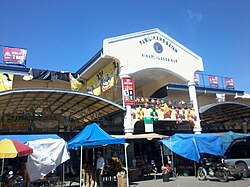Sinait, Ilocos Sur
| Sinait | ||
|---|---|---|
| Municipality | ||

Sinait Public Market
|
||
|
||
 Map of Ilocos Sur showing the location of Sinait |
||
| Location within the Philippines | ||
| Coordinates: 17°52′00″N 120°27′30″E / 17.8667°N 120.4583°ECoordinates: 17°52′00″N 120°27′30″E / 17.8667°N 120.4583°E | ||
| Country | Philippines | |
| Region | Ilocos (Region I) | |
| Province | Ilocos Sur | |
| District | 1st District | |
| Barangays | 44 | |
| Government | ||
| • Mayor | Glenn B. Guzman | |
| Area | ||
| • Total | 65.56 km2 (25.31 sq mi) | |
| Population (2015 census) | ||
| • Total | 25,640 | |
| • Density | 390/km2 (1,000/sq mi) | |
| Time zone | PST (UTC+8) | |
| ZIP code | 2733 | |
| IDD : area code | +63 (0)77 | |
| Income class | 3rd class | |
Sinait is a third class municipality in the province of Ilocos Sur, Philippines. According to the 2015 census, it has a population of 25,640 people. It is the northernmost municipality of the province and is 36 kilometres (22 mi) from the provincial capital, Vigan, 46 kilometres (29 mi) from Laoag, and 441 kilometres (274 mi) from Manila.
Because of its main commodity, garlic, Sinait is also known as the Garlic Center of the North.
Sinait is politically subdivided into 44 barangays.
Before Magellan discovered the Philippines in 1521, the locality was only a small village of little over a hundred natives who were called "Tirongs." By nature, these primitive inhabitants were sea-faring warlike. In their fast and picturesque sailboats, they traveled to adjoining and distant places, most particularly to settlements and villages along the Ilocos Coast in Ilocos Norte, Ilocos Sur, La Union, Pangasinan and even Zambales. In those adventures, the “Tirongs “ always challenged the people encountered to tribal wars and fought small battles against them. Often, those sturdy and brave natives came out victorious. Even in their daily chores, those people showed their ferocious characteristics. When the renowned Iberians came, Salcedo was sent to explore and colonized the Ilocos territory during the early years of the Spanish regime, he found the “Tirongs” of Sinait in apogee of the social state. Small battles were daily occurrence so that in the year 1535, when the locality was organized and established as a “Pueblo” Salcedo named the new community as “SIN-NAIT”, a word in the local tongue which means “CONTEST”. As a pueblo, SINAIT embraced and included in its territorial limit such as distant places as RANCHERA DE PAUR”, now the Municipality of Nueva Era in Ilocos Norte and Southern barrios of Badoc of the same Province. The vast territory, however, was reduced to present 78 square kilometers. In the year 1575, the natives fully realized the hardships of pronouncing the term “SIN-NAIT” and to go away with the trouble, Salcedo declared that one of the letter “N” be dropped. Since then, this Municipality has been called “SINAIT”. Nevertheless, it was only in 1913 when the same was “deeded” by the government upon the initiative of the late Don Calixto Cabacungan so that the Municipality Council enacted a resolution to that effect, that SINAIT was adopted as official name of the community to which said resolution was duly approved by the Provincial board of Ilocos Sur and by the Defunct Philippine Legislature.
...
Wikipedia


